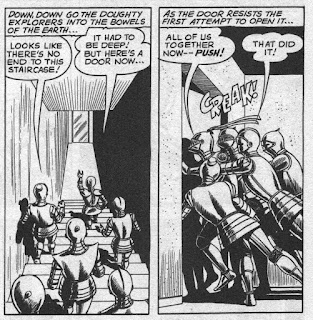The 1970s
by Jason Sacks
TooMorrows Publishing, 2014
'American Comic Book Chronicles: The 1970s' (287 pp) is one of a series of books released by TooMorrows Publishing that chronicle the history of American comic books. Other volumes in the series cover the 1950s, the 1960s, and the 1980s.
This is a great book. If you are at all interested in American comic books, or American pop culture of the 70s, you will want to get it.
I was a big comic book fan in 1970, the initial year in this volume. I scrounged my pennies and nickels and dimes and bought several issues a month - almost always Marvel comics.
By the mid-70s my interest in comic books was waning, in part because of continuous rounds of price increases - back in those days, a dime or a quarter was a big chunk of change for a kid - and the page counts not only dropped, but in Marvel's case, were often made up of reprints.
I did get back into buying comics in the later 70s, but it wasn't comic books I bought, but rather, issues of Heavy Metal ........and some of what were being called 'graphic novels'.
Reading 'ACBC: The 1970s' brings it all back.
The book uses a narrative format, with each year receiving its own chapter, and a two-page Timeline that provides the major events in comic book publishing and in American history.
The pages that I've scanned and posted here will give you a sense of the depth of coverage provided to the surveyed comics, as well as the personalities and businesses associated with the comics.
The narratives necessarily focus on the bigger events of the era, such as Jack Kirby's move to DC; the 1971 battles with the Comics Code over the Spider Man issues dealing with drug abuse; and the back-and-forth price wars between Marvel and DC in that same year.
Also getting attention are the rise, and steep fall, of the underground comix during the early 70s; the success of the Warren black and white magazines, and the rise of Marvel as the dominant comic book publisher in the industry.
The latter chapters deal with the increasingly unprofitable condition of the industry, dependent as it was on a network of some 500 independent distributors to place the comics on the shelves and racks in retail stores - and truthfully report sales figures.
One thing 'ACBC: The 1970s' does very well is reveal the precarious economics that governed the industry throughout the decade, and left Marvel near bankruptcy in 1977 - according to Jim Shooter, only the massive success of Star Wars saved the company.
DC failed to find as successful a franchised property, and, as the book relates, in 1978 suffered the disastrous 'DC Implosion' that led to layoffs, cancelled books, and a retrenchment that lingered well into the early 80s.
Economic troubles increasingly characterized the industry in the latter half of the decade, although there were signs that the public was ready to embrace alternate comics, particularly if these adopted the European attitude towards graphic art - as Heavy Metal magazine was to discover.
The book closes on a sobering note: at the start of the decade, the average Marvel or DC comic book cost 15 cents and provided around 20 pages of new content. By the end of 1979, the average comic book cost 40 cents and provided 17 pages. In 1970, Archie, one of the industry's biggest sellers, sold an average of 483,000 copies a month. In 1977, sales dropped to 155,000 per month, and in 1983, to 70,000 per month.
This troubling picture of declining sales was true for every comics publisher as the 1970s ended. Many inside and outside the industry predicted that comic books were fated to die out, much as the pulp magazines had died out during the 1950s. As we now know, the industry would undergo a revival of fortune in the early 1980s, but as 1979 came to an end, the overall picture was bleak.
Summing up, I reiterate: you'll need to get a copy of 'American Comic Book Chronicles: The 1970s'. The combination of tiny, fact-packed font, and high-quality illustrations, means this is one book you're going to have hard time putting down.........





















































































